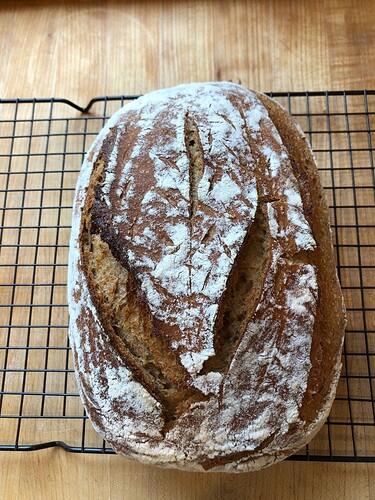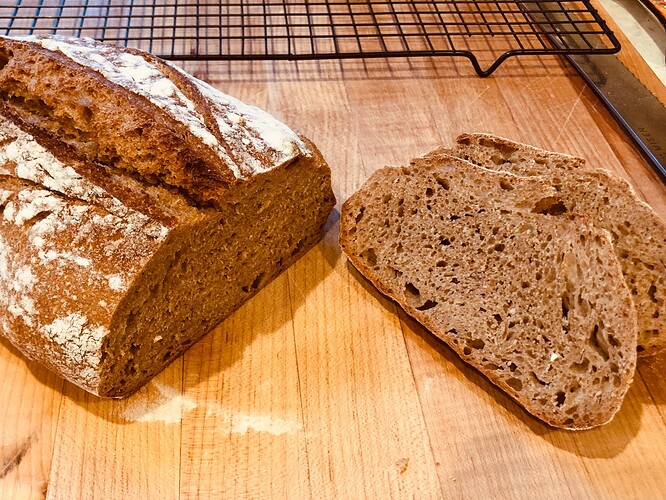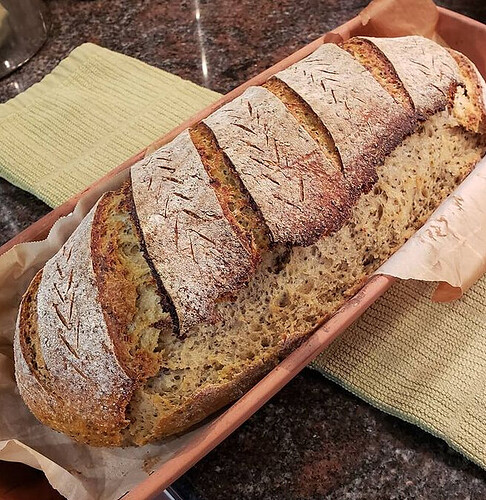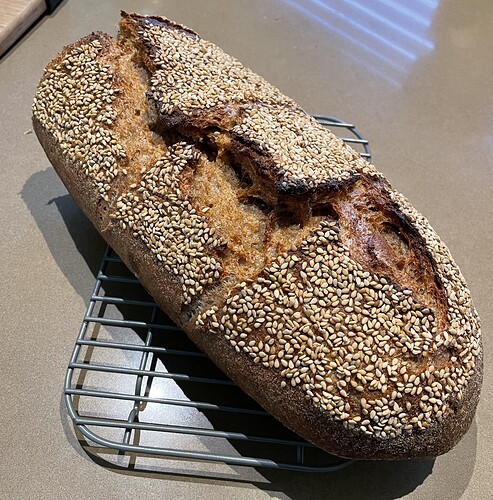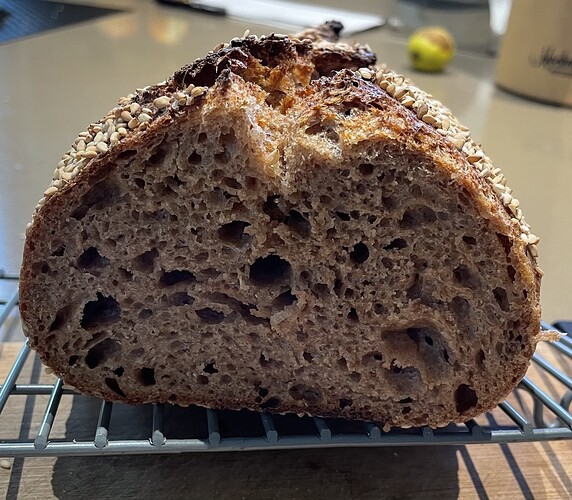Thanks, Morgana. I’m sure that you will enjoy the taste, and I look forward to seeing your photos.
Richard
go to chefsteps.com for an excel spreadsheet you can download and make your own, they also have a handy chart. If you look up a couple of posts to Melissa I gave her a link to adding eggs in baked goods also. Like I said before I don’t consider adding things like these to be cheating as the millers do, why not you? If you are using bread flour you are adding additives to your wholegrain.
Also if you go to the readers recipes you will find a post for Sourdough Wholegrain with Egg. There is also a link to the recipe I used to make the home milled wholegrain sourdough using two weak flours. I believe I included the % of each in the flour, if not easily figured.
Personally I would rather not add VWG as frankly you don’t know how it was processed or from what wheat. As I said to Melissa my next Home Milled Wholegrain will include 2 eggs and MY BET is the dough will react just as good as adding VWG and it really makes for a nice texture. Nothing ventured nothing lost!
Now if you don’t have a weak stomach I can send you research some from the CDC regarding the hybrid wheat they are allowing the populous to eat. I found it quite distressing and then people wonder why we have an epidemic of heart disease, metabolic syndrome, diabetes, uric acid gout, population weight gain, gluten intolerance and a couple of others. Between the wheat and high fructose corn syrup (my Rheumatologist calls the later metabolic poison) they are literally causing diseases. But I guess they couldn’t sell any drugs if there wasn’t any disease huh!!! I don’t remember if I still have the documentation on the hybrid wheat but somehow the gluten content of the proteins is drastically higher than the ancient grains. An example is you would have to eat over 100 slices of bread in the 60’s to equal the content of gluten in 6 slices of store bought today. I am not sure about even the organic wheat we pay dearly for as a person has to pull teeth to find out what they are selling us. Sorry state of affairs.
Melissa, thank you for your reply.
I actually meant “pointers” to determine when to stop the Bulk Fermentation & the Final Proof.
I think it’s important, as each dough batch has limited potential/ability to ferment (result of flavor & crumb). So, how much we allow to ferment before the bake has important effect on the result.
Thanks again
Ytzhack
Richard, that crumb is outstanding, super impressive. I’d certainly be proud to have baked that loaf. Well done.
Benny
Would this work with only Kamut? Spelt is an intolerance for me but I love Kamut.
Ah I understand your question now. For whole grain and lower gluten wheats, I tend to end the bulk fermentation at about 75% expansion, bumpy on the top (bubbles don’t happen much with these flours in my experience), webby on the bottom when flipped out of the bowl. This may be on the far side for a whole grain dough, but I like the flavor and crumb of an extensive ferment.
Then I shape pretty aggressively and let the dough expand “some” in the basket. I put photos of the final proof – beginning and end – in the gallery at the end of the recipe post to try to give a visual of this. The photos in this case are of the dough that was proofed in the refrigerator.
Here’s a good explanation and video by @Benito of how to use an aliquot jar – this is a helpful way to track fermentation, especially when you’re handling and degassing the dough for gluten development.
I don’t use the jar usually, but it’s a good tool for the toolbox.
Kamut’s gluten is weaker than spelt’s in my experience, but I think it’s certainly worth a try. I’d love to hear how it goes.
I did an all kamut loaf in this recipe post (kamut three ways: 20%, 40% and 100%). I suspect I let the 100% kamut dough ferment too much and could have had more structure to the final bread had I stopped the bulk earlier. (The photo is not the 100% bake lol.)
Thanks, Benny, you are always encouraging.
Richard
Thank you, Melissa!
Hi Jane,
My neighbor uses a 3 1/2 qt Staub cast iron Dutch oven and baked this loaf for me today. It turned out wonderfully. I took pictures but do not know how to load them here. Try it in your Le Creuset. I think you’ll be pleased.
Olga
This was the most challenging bread I’ve made to date. (Made version 2)
Thank you for not just the awesome recipe but for one that was easy to follow and the pictures that made it possible to keep on and not give up!
The bread turned out great. Lots of nice air pockets. Tastes great with a lovely nutty flavor and with a good crust.
I was not sure how many time to fold during the 5 hours so did about 8 folds. The rest was as written.
It’s wonderful to hear that you enjoyed the bread and found the recipe instructions helpful. And congratulations on taking on the extra challenging formula.
@Fermentada I’ve made this bread twice now, and am completely in love with the flavor! I used the lower hydration version, but will try the higher hydration eventually. I’ve been using my batard clay baker, and while I get nice oven spring, and a decent crumb, my scoring is atrocious. I tried to mimic your wheat design and completely failed - LOL Today I am going to try baking in my oblong clay baker and see what the difference is. I also love your Kamut recipe, which I’ve done 50/50 with Kamut and Bread flour, also one of my go-to’s. Mainly, I have to thank you for your videos of the different types of gluten development. They make it so easy to follow, and I am now capable of laminating and coil folding - so exciting!
That is a fantastic loaf! The color and crumb are amazing. I have score blowouts too : )
Here’s the pattern I still have the most trouble with. In this loaf, I practically got an ear from a cut I didn’t even make.
I’m glad you’ve found the gluten development videos helpful. You may have already seen it, but here’s a similar blog post with videos on scoring.
The main takeaway for doing decorative wheatstalks is to make the ear slash quite deep and the wheatstalk shallow, particularly the stem should be almost a tracing.
The baker who illustrates that approach the best imo is @danlarn on Instagram. Here’s a video post of his.
Thanks for sharing the photo of a blowout - makes me hopeful if they even happen to you! And thanks for the links also. So great to have such helpful teachers on this forum.
Strangely, my first attempt at this bread was my best (beginner’s luck?) in terms of crumb. Just made one yesterday, and while it was tasty, the crumb was more dense. I think maybe I overproofed the bulk fermentation due to timing issues with having to get dinner ready at the same time that I should have baked the loaf. But at least it’s not a brick!
Off topic because this is not a spelt/kamut bread (but is 100%whole grain) but I had to send this photo of a recent bake that had a mind of its own despite my three cross slashes! Great crumb though.
Wow, just like mine. It must be something with the cross scoring on oblong loaves. Too much pressure going up and/or no way to expand laterally maybe.
@j4m3s4j, whom I mention in the recipe post above as inspiring this wheat combination, just posted about whole grain pizza made with spelt and Kamut.
I thought I’d share a link to the photos and formula in this thread. It sounds delicious and makes sense from the structure/gluten standpoint, with spelt bringing extensibility to the dough and khorasan/Kamut adding protein/strength.
Here is the formula for the pizza Melissa mentioned:
248g Water (72.1%)
44g Starter (100% hydration) (12.8%)
172g Milled Spelt (50%)
172g Milled Kamut (aka Khorasan)
(50%)
7g Salt (Pink Salt) (2%)
I mix everything together. Give it a couple rounds of strength and conditioning, then wait for the bulk to complete. Which for this seems to be when it has nearly doubled. I then divide and shape into 2 balls and store in the fridge. This formula seems to be on the edge of over fermenting at about 2 days in the fridge.
Your bread looks amazing!! I’ven been “trying” to bake with freshly milled spelt for several months now. Most of my bread spreads out like a pancake in the oven. The flavor is very good though. Sometimes I do get some oven spring but nothing like yours. What am I doing wrong??? Could I use 100% spelt flour? Do you think if I follow your recipe. Was the version with lower hydration sour? I really want to bake a loaf using only three ingredients. I hope you can help me out!!!
Thanks,
Nickie
